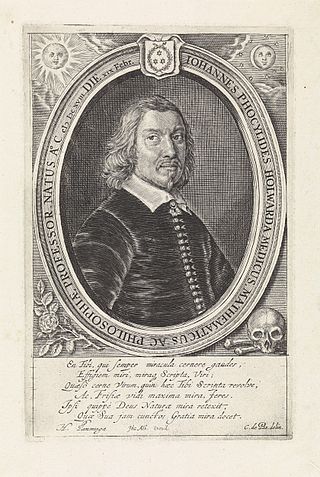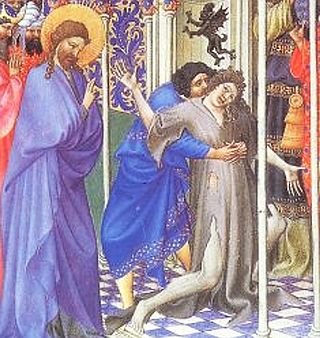Related Research Articles
The Unknown God or Agnostos Theos is a theory by Eduard Norden first published in 1913 that proposes, based on the Christian Apostle Paul's Areopagus speech in Acts 17:23, that in addition to the twelve main gods and the innumerable lesser deities, ancient Greeks worshipped a deity they called "Agnostos Theos"; that is: "Unknown God", which Norden called "Un-Greek". In Athens, there was a temple specifically dedicated to that god and very often Athenians would swear "in the name of the Unknown God". Apollodorus, Philostratus and Pausanias wrote about the Unknown God as well.
Phocylides, Greek gnomic poet of Miletus, contemporary of Theognis of Megara, was born about 560 BC.

The Nephilim are mysterious beings or people in the Hebrew Bible who are described as being large and strong. The Hebrew word Nephilim means "giants"; some understand it to mean "the fallen ones" but this is a misunderstanding of The Hebrew. Their origins are disputed. Some, including the author of the Book of Enoch, view them as offspring of fallen angels and humans. Others view them as offspring of the descendants of Seth and Cain.

Pseudepigrapha are falsely attributed works, texts whose claimed author is not the true author, or a work whose real author attributed it to a figure of the past. The name of the author to whom the work is falsely attributed is often prefixed with the particle "pseudo-", such as for example "pseudo-Aristotle" or "pseudo-Dionysius": these terms refer to the anonymous authors of works falsely attributed to Aristotle and Dionysius the Areopagite, respectively.
The Testament of Adam is a Christian work of Old Testament pseudepigrapha that dates from the 2nd to 5th centuries AD in origin, perhaps composed within the Christian communities of Syria. It purports to relate the final words of Adam to his son Seth; Seth records the Testament and then buries the account in the legendary Cave of Treasures. Adam speaks of prayer and which parts of Creation praise God each hour of the day; he then prophesies both the coming of the Messiah and the Great Flood; and finally, a description of the celestial hierarchy of angels is given.
The Life of Adam and Eve, also known in its Greek version as the Apocalypse of Moses, is a Jewish apocryphal group of writings. It recounts the lives of Adam and Eve from after their expulsion from the Garden of Eden to their deaths. It provides more detail about the Fall of Man, including Eve's version of the story. Satan explains that he rebelled when God commanded him to bow down to Adam. After Adam dies, he and all his descendants are promised a resurrection.
Pseudo-Philo is the name commonly used for the unknown, anonymous author of the Biblical Antiquities. This text is also commonly known today under the Latin title Liber Antiquitatum Biblicarum, a title that is not found in the Latin manuscripts. Although probably originally written in Hebrew, it is preserved today only through a Latin translation found in 18 complete and 3 fragmentary manuscripts that date between the eleventh and fifteenth centuries CE. In addition, material paralleling that in the Biblical Antiquities is also found in the Chronicles of Jerahmeel, a 14th-century Hebrew composition. The Latin text of the Biblical Antiquities circulated alongside Latin translations of the authentic writings of Philo of Alexandria. Scholars have long recognized the pseudonymous character of the text now known as the Biblical Antiquities. Primary in this regard is a vastly differing approach to and use of the Jewish scriptures. For the sake of convenience, scholars continue to follow the lead of Leopold Cohn in calling the unknown author "Pseudo-Philo".

The New Testament apocrypha are a number of writings by early Christians that give accounts of Jesus and his teachings, the nature of God, or the teachings of his apostles and of their lives. Some of these writings were cited as scripture by early Christians, but since the fifth century a widespread consensus has emerged limiting the New Testament to the 27 books of the modern canon. Roman Catholic, Eastern Orthodox, and Protestant churches generally do not view the New Testament apocrypha as part of the Bible.

Joseph and Asenath is a narrative that dates from between 200 BCE and 200 CE. It concerns the Hebrew patriarch Joseph and his marriage to Asenath, expanding the fleeting mentions of their relationship in the Book of Genesis. The text was translated widely, including into Amharic, Arabic, Armenian, Early Modern German, Latin, Middle English, Old French, Romanian, Serbian and Syriac.

Johannes Phocylides Holwarda was a Frisian astronomer, physician, and philosopher. He was a professor of philosophy at the University of Franeker from 1639 to 1651.
Ezekiel the Tragedian – also known as Ezekiel the Dramatist and Ezekiel the Poet – was a Jewish dramatist who wrote in Alexandria. Naomi Yavneh has placed his work in the 3rd century BCE, while Howard Jacobson estimates the 2nd century BCE. Evidence of the date is not definitive.
The Greek Apocalypse of Daniel is a Christian pseudepigraphic text attributed to the Biblical Daniel and so associated with the Hebrew Bible. No Jewish or Christian groups regard this text as canonical or as authoritative scripture. The canonical Book of Daniel has much apocalyptic imagery, and this apocalyptic-style text deals with a similar subject, describing one particular vision of Daniel regarding the appearance and activities of the Antichrist before the Day of Judgement.
Pieter Willem van der Horst is a scholar and university professor emeritus specializing in New Testament studies, Early Christian literature, and the Jewish and Hellenistic context of Early Christianity.

In English translations of the Bible, unclean spirit is a common rendering of Greek pneuma akatharton, which in its single occurrence in the Septuagint translates Hebrew ruaḥ tum'ah.
Demetrius the Chronographer was a Jewish chronicler (historian) of the late 3rd century BCE, who lived probably in Alexandria and wrote in Greek.

The Exhortation to the Greeks is an Ancient Greek Christian paraenetic or protreptic text in thirty-eight chapters.
Pseudo-Orpheus is the name of a poetic text, preserved only in quotations by various Christian writers, which has a complex history. Pseudo-Orpheus appears in multiple recensions. The poem presents the legendary Greek figure Orpheus as giving a poetic speech to his son, Musaeus, identified as the biblical Moses, passing on to him hidden wisdom he learned in Egypt. It presents a monotheistic view of God, whom, according to the poem, no one has seen, except for Abraham, who was able to see God due to his skill at astrology.

The manuscript 4Q127 is one of the Dead Sea Scrolls. It is probably a paraphrase of Exodus according to the Septuagint (LXX) of the biblical Book of Leviticus, found at Qumran. The Rahlfs-No. is 802. Palaeographically it dates from the first century BC. Currently the manuscript is housed in the Rockefeller Museum in Jerusalem.
Gerard Mussies is a retired senior lecturer in the New Testament Hellenistic background at the Faculty of Theology at the University of Utrecht, The Netherlands. He taught biblical Greek and studied the Greek-Roman background of the New Testament.
References
- 1 2 3 Toy, Crawford Howell; Krauss, Samuel. "PSEUDO-PHOCYLIDES". Jewish Encyclopedia. Retrieved 14 October 2018.
- ↑ Klawans, Jonathan (2018). "Deceptive Intentions: Forgeries, Falsehoods and the Study of Ancient Judaism". Jewish Quarterly Review. 108 (4). Project Muse: 489–501. doi: 10.1353/jqr.2018.0030 . ISSN 1553-0604. S2CID 165452745. at page 493
- ↑ P. W. van der Host, Pseudo-Phocylides (First Century B.C.-First Century A.D.. A New Translation and Introduction, in James H. Charlesworth (1985), The Old Testament Pseudoepigrapha, Garden City, NY: Doubleday & Company Inc., Volume 2, ISBN 0-385-09630-5 (Vol. 1), ISBN 0-385-18813-7 (Vol. 2), p. 567.
- 1 2 Cheung, Luke L. "The Sentences of Pseudo-Phocylides". University of St. Andrews.
- ↑ Charlesworth, James H. The Old Testament pseudepigrapha & the New Testament. OCLC 39727693.
- ↑ James B. Adamson (1989). James: The Man and His Message. Wm. B. Eerdmans Publishing. pp. 82–. ISBN 978-0-8028-0167-8.
- ↑ Johnson, Luke T. (1982). "The Use of Leviticus 19 in the Letter of James". Journal of Biblical Literature. 101 (3): 391–401. doi:10.2307/3260351. JSTOR 3260351.
- ↑ van der Horst, Pieter Willem (1978). The sentences of pseudo-Phocylides : with introduction and commentary. Leiden : E.J. Brill. OCLC 54126914.
- ↑ line 175, p. 99, The sentences of Pseudo-Phocylides, translated by Pieter Willem van der Horst
- ↑ line 187, p. 101, The sentences of Pseudo-Phocylides, translated by Pieter Willem van der Horst
- ↑ line 192, p. 101, The sentences of Pseudo-Phocylides, translated by Pieter Willem van der Horst
- ↑ line 212, p. 101, The sentences of Pseudo-Phocylides, translated by Pieter Willem van der Horst
- ↑ Macrone, Michael (2003). It's Greek to me! : brush up your classics, Pseudo-Phocylides, Wise Sayings, lines 122-128. New York : Cader Books. p. 200. ISBN 9780062720443. OCLC 915861079.
- 1 2 Wilson, Walter T. (2005). The Sentences of Pseudo Phocylides (e-book).
- ↑ Wilson, Walter T. (2005). The Sentences of Pseudo-Phocylides. Berlin ; Boston: De Gruyter. OCLC 979850022.